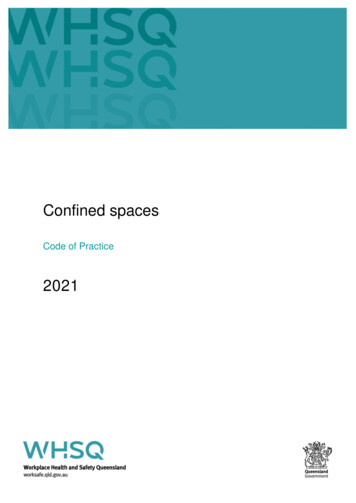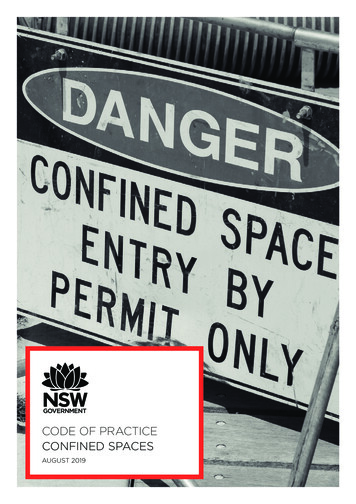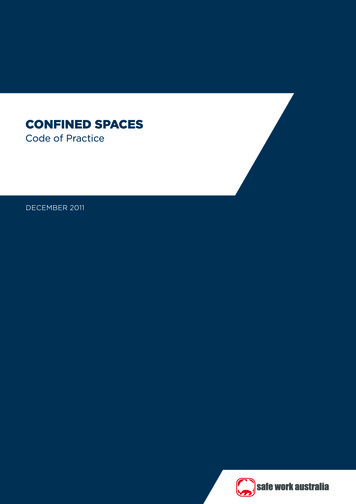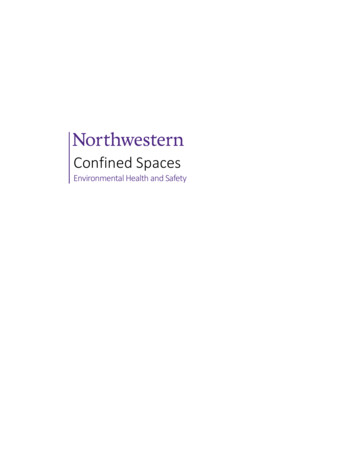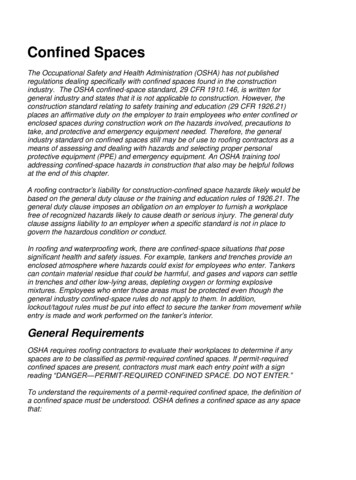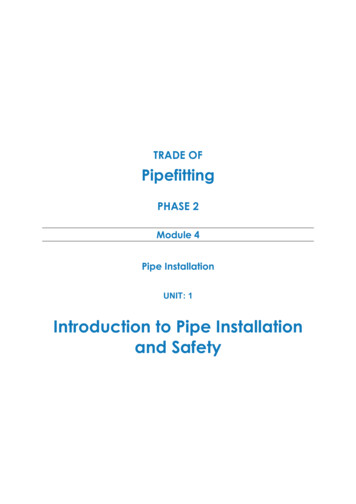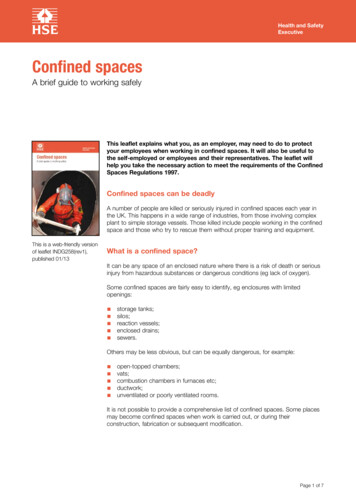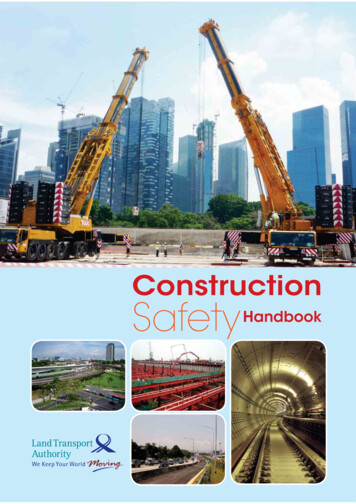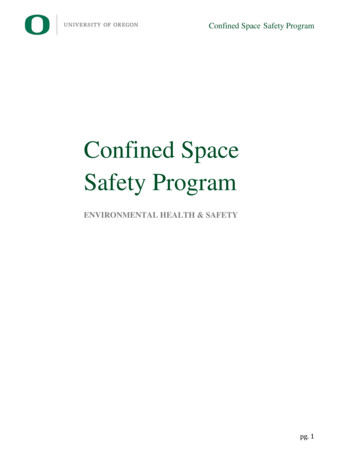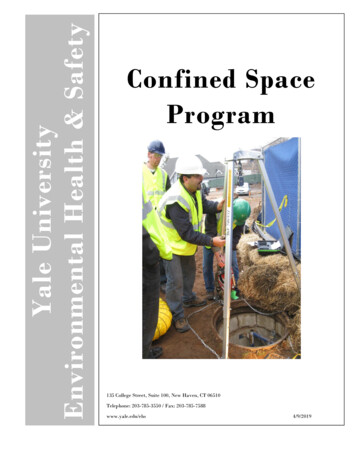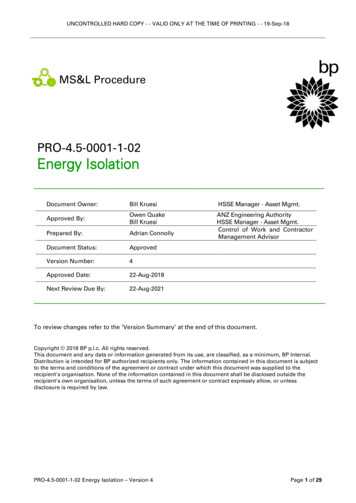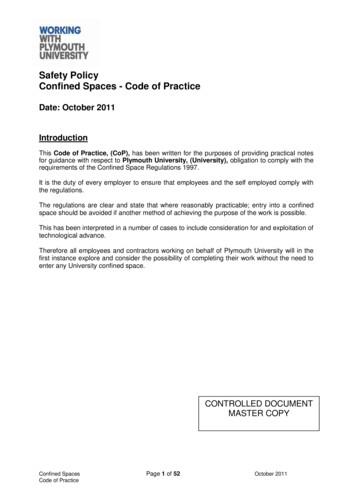
Transcription
Safety PolicyConfined Spaces - Code of PracticeDate: October 2011IntroductionThis Code of Practice, (CoP), has been written for the purposes of providing practical notesfor guidance with respect to Plymouth University, (University), obligation to comply with therequirements of the Confined Space Regulations 1997.It is the duty of every employer to ensure that employees and the self employed comply withthe regulations.The regulations are clear and state that where reasonably practicable; entry into a confinedspace should be avoided if another method of achieving the purpose of the work is possible.This has been interpreted in a number of cases to include consideration for and exploitation oftechnological advance.Therefore all employees and contractors working on behalf of Plymouth University will in thefirst instance explore and consider the possibility of completing their work without the need toenter any University confined space.CONTROLLED DOCUMENTMASTER COPYConfined SpacesCode of PracticePage 1 of 52October 2011
List of ContentsApplicationPages 3 - 4Definitions and AbbreviationsPages 5 - 7Confined Spaces Procedure and Risk AssessmentsPages 8 - 14Emergency ProceduresPage 14Training and CompetencyPages 15 – 16Record of RevisionsPage 17AuthorisationPage 17Register of Confined Spaces and Controlled AreasAppendix AAssociated Departments.Appendix BPotentially Hazardous Areas - Checklist.Appendix CAuthorised Persons & Permit DistributionAppendix DContractor Documentation Check SheetAppendix EConfined Space Permit to WorkAppendix FContractors Audit SheetAppendix GConfined Space Emergency Procedure FormAppendix HWarning SignAppendix IRisk Assessment FormAppendix JConfined Space Work in Progress Warning SignAppendix KMedical for Confined Space WorkersAppendix LConfined SpacesCode of PracticePage 2 of 52October 2011
ApplicationDuring the application of this code of practice, regard should be given to the followinglegislation: The Health & Safety at Work Act 1974The Management of Health & Safety at Work Regulations 1999The Control of Substances Hazardous to Health Regulations 2002, (as amended).The Provision and Use of Work Equipment Regulations 1992The Personal Protective Equipment at Work Regulations 2002The Electricity at Work Regulations 1989The Control of Asbestos at Work Regulations 2006The Noise at Work Regulations 2005The Construction (Design & Management) Regulations 1994The Construction (Health, Safety and Welfare) Regulations 1996The Workplace (Health, Safety and Welfare) Regulations 1992The Control of Lead at Work Regulations 1980Any subsequent revisions, extensions or amendments to the aforementioned legislation wouldalso apply to the guidelines offered in this CoP.Similar Codes of Practice and University safety documents are available for use as guidanceon other regulatory requirements and collectively form part of the University's SafetyManagement System.The Confined Spaces Regulations came into force on the 28th January 1998 and apply topremises and places of work In Great Britain.The regulatory definition given for a Confined Space is "any place, including chamber, tank,vat, silo, pit, trench, pipe, sewer, flue, well or other similar space in which, by virtue ofits enclosed nature, there arises a reasonable foreseeable specified risk".The "specified risk" means a risk of – serious injury to any person at work arising from a fire or explosion the loss of consciousness of any person at work arising from an increase in bodytemperature. the loss of consciousness or asphyxiation of any person at work arising from gas, fume,vapour or the lack of oxygen. the drowning of any person at work arising from an increase in the level of a liquid the asphyxiation of any person at work arising from a free flowing solid or the inability toreach a respirable environment due to entrapment by a free flowing solid.Application of the regulations to various types of confined space will be according to the risksinvolved with the particular type of work to be carried out within the space.If entry to a particular confined space is unavoidable then entry must be in accordance with aSafe System of Work, (SSOW), which, in relation to relevant specified risks, renders thatwork safe and without risks to health.Additionally entry into a confined space requires the preparation of suitable and sufficientrescue arrangements which should include provision of resuscitation equipment where aspecified risk has been identified.These arrangements should also ensure the risks to those carrying out a rescue, as far asreasonably practicable, are minimised.Confined SpacesCode of PracticePage 3 of 52October 2011
In all cases the identification and subsequent designation of an area as a confined spacerequires a suitable and sufficient risk assessment to be undertaken by a competent personthis will ensure that a SSOW will be in place, before any entry or work is allowed tocommence.In the case of the University the regulations and the accompanying responsibility will apply toall buildings and areas owned, leased and maintained by the University across all campuses.All confined spaces and controlled areas on the Plymouth campus have been identified, riskassessed and included on a register of confined spaces.University confined spaces will have a category number and an identification number, thecategory number will reflect the category of the space with regard to the degree of riskrepresented by that space, the identification number will be used to reference the applicablerisk assessment for that unique space.The risk assessment for the space will be complimented by a further risk assessment whichwill highlight the hazards and risks associated with the work within the environment of theconfined spaceIn these guidance notes, advice and examples will be given on possible risks, carrying out aninitial risk assessment, the institution of safe systems of work, rescue equipment/proceduresand the level of training expected.Recommended safety measures may be partly or wholly instituted depending on the identifiedrisks involved; as a consequence some areas may be designated as low-risk category 3confined spaces with respect to purely inspection activities or other tasks that require onlyminimal disturbance to the contents of the space.These areas are listed on a register of „Confined Spaces and Controlled Area RiskAssessments‟, attached in appendix A of this document.This register is to remain live and be updated periodically by the responsible person at leastannually or when additional areas are established.However it should be remembered, that there may be occasions when a low risk category 3confined space will become high risk by the introduction of certain types of work, materials orsubstances.In response to the requirements of the regulations it is therefore not permitted that any personwhether staff, contractor or member of the public should enter any area with any anticipatedlevel of risk that would be considered to be a confined space under the definition.If access is required then these guidelines should be followed in conjunction with the fullknowledge of the Directorate of Estates and Facilities Management and accompanied byany necessary permits to work.As a consequence of this, there will be the prohibition of access to certain areas of theUniversity which hitherto may have been accessible by various personnel.Confined SpacesCode of PracticePage 4 of 52October 2011
Definitions and AbbreviationsDefinitionsConfined Space - any place, including chamber, tank, vat, silo, pit, trench, pipe, sewer, flue,well or other similar space in which, by virtue of its enclosed nature, there arises a reasonableforeseeable specified risk.The University confined spaces have been categorised 1, 2 and 3, being dependent upon anumber of risk factors, category 1 is considered to be high risk, category 2 is considered to bemedium risk, Category 3 is considered to be low risk.A „warning‟ sign is located adjacent to the entrance of the confined spaces providing specificspace information, access instructions and contact details. A sample of the warning sign canbe seen in appendix I.Readers are reminded that by definition confined spaces are dangerous places.Category 1 - Confined Space status is afforded to those confined spaces where a significantrisk of serious injury is likely to occur as a consequence of a recognised represented hazardwithin or brought into the confined space, however the rescue or recovery of injured ordistressed workers will be difficult and time consuming. The space classification and categorystatus will be located after to the unique identification number e.g. 01/CS/01Category 2 - Confined Space status is afforded to those confined spaces where a significantrisk of serious injury is likely to occur as a consequence of a recognised represented hazardwithin or brought into the confined space, and the rescue or recovery of injured or distressedworkers can be executed quickly and easily by the trained team. The space classification andcategory status will be located after to the unique identification number e.g. 01/CS/02Category 3 - Confined Space status is afforded to those confined spaces where the space islargely enclosed, there is a minimal risk of injury as a consequence of the presence ofrecognised represented hazards within the confined space, access to the space is on thesame level and is walk in, walk out, the rescue and recovery of injured or distressed workers iseasy, convenient and requires few skills other than appropriate levels of first aid. The spaceclassification and category status will be located after to the unique identification number e.g.01/CS/03A Permit to Work (PTW) will be required for entry into confined spaces categories 1, 2 and 3.Category 4 - Controlled Area Status is afforded to those areas which are substantiallyenclosed but fall outside the scope of the confined space definition, but common sensedictates should be controlled. This category “Controlled Area” will be designated by the letters(CA) on the risk assessment and the entry point.The space classification and category status will be located after to the unique identificationnumber e.g. 01/CA/04For practical purposes these areas will be controlled areas, where possible these areas will besigned “Authorised Persons only” and be secured, access to these areas is through keycontrol by the Appointed Person.Departments, contractors or others who wish to enter these areas are reminded that anyactivity other than simple inspection / access, will attract the requirement of a specific activityrisk assessment.Confined SpacesCode of PracticePage 5 of 52October 2011
Any work activity that produces or is likely to produce any confined space prescribed hazard,ie hazardous gas, fume, vapour, dust or which compromises the atmosphere within willimmediately attract the Confined Spaces Regulations and would therefore be subject to theapplication of the University confined spaces code of practice.It is not un-common for these controlled areas to be used as store facilities within theUniversity and will be available to the appointed person (see definition below) only, these areawill be subject to formal key control.The recovery of materials and equipment from these controlled areas will be subject to aformal risk assessment, these activities / areas will be supervised by an appointed person.During the recovery of materials and equipment from these controlled areas a permit to work,(PTW), will not be necessary.All staff are reminded that the controlled area category 4 designation, does not mean no risk,the category designation should not be used as an alternative to the generation of a taskspecific risk assessment and a PTW as the nature of, and the conditions in, any area or spacecan change.These areas are identified on the Register in appendix A to this document.Associated Departments – are departments either within the university or associated withthe university that may be affected by; have direct association with; or have an interest in theworks themselves or the confined space where the works are being undertaken.The associated departments are also departments who may also be planning works within theconfined space.The associated departments shall be deemed as the following: Estates and Facilities, Management, (E&FM).Information and Learning Services, (ILS).University Secretariat (Governance, Planning and Registry), Safety Office.A list of the contacts for these departments is attached in appendix B. NB: This document isto remain live for updating by the responsible person.Authorised Person, (authorised permit signatory) - should be a E&FM or ILSrepresentative with sufficient training, experience and familiarity of the works / task beingundertaken together with relevant processes, plant and equipment to understand the risksinvolved with the works and working in confined spaces and can evaluate precautions thatmeet the requirements of the regulations.The authorised person would be deemed eligible to sign the PTW for contractors undertakingworks under their instruction; the authorised person will carry out the relevant checksassociated with the permit and periodically audit proceedings to an appropriate level.Please refer to appendix C of this document for a list of the authorised persons. NB: Thisdocument is to remain live for updating by the responsible person.Competent Person – is someone with the sufficient level of training together with experienceof, and familiarity with, the relevant processes, plant and equipment so that they understandthe risks involved and can devise precautions that meet the requirements of the regulations.The competent person will develop and provide the relevant safe system of work, riskassessment, method statement to the Authorised Person in order to obtain a confined spacePermit to Work.Confined SpacesCode of PracticePage 6 of 52October 2011
Where there is likelihood of multiple risks being present requiring specific expertise to analyse,more than one person may be required to contribute to the risk assessment.The required task will determine who the competent person should be.Operative – is someone suitably trained to undertake the works within the confined space andwill meet the specified criteria below.1. The operator will be familiar with the regulations;2. She / he will have a technical understanding of the work and the safe system to beemployed;3. They will be familiar with all plant and equipment particular to the works; hazards /precautions and risks associated with carrying out works within a confined space;4. They will have an understanding of typical emergency situations and the need to followprepared emergency arrangements;5. They will have knowledge of the practical use of safety equipment and safety featuresfor this type of work.Permit-to-Work (PTW) - a safety document issued by the Authorised Person when it isnecessary to work in an area designated as a “Confined Space” or a similar area that by itspotentially hazardous nature should be categorised as requiring the same level of precautions,e.g. area of restricted access.Reasonably Practicable - requires that a judgement is made by the authorised / competentperson as to what is reasonable, taking into account the degree of risk as against cost, time oreffort in averting the risk.Responsible Person - the person appointed by the University responsible for the operationaland safety policy with respect to Confined Space Regulations including the certification ofpersonnel.Appointed Person - is someone appointed by a particular department to take control of, andbe responsible for, access to a controlled area that is used as a store facility or similar.The appointed person will supervise the safe storage and recovery of equipment andmaterials and ensure the space remains clean and tidy.Safe System of Work, (SSOW) - is defined as the necessary arrangements which, in relationto relevant specified risks, renders work safe and without risks to health.Safety Documents - the documents issued by the University as part of their safety policy andthe CoP for Confined Spaces.Supervisor - is someone suitably trained to supervise access to the confined space andworks being carried out within. The Supervisor is also referred to as the Top Man.The supervisor would control access, the method of work, the SSOW and be responsible forthe execution of emergency procedures, if required.Familiarity with the University confined spaces safety policy / CoP; relevant processes, plantand equipment particular to the works; knowledge of risks associated with the works / spaceand their continual presence at the access point during all instances of entry are allprerequisites.Confined SpacesCode of PracticePage 7 of 52October 2011
AbbreviationsCoPF&RSE&FMPTWSSOWUniversityILS Code of PracticeDevon & Somerset Fire & Rescue ServiceEstates & Facilities ManagementPermit to WorkSafe System of WorkPlymouth UniversityInformation and Learning ServicesConfined Space Procedures and Risk AssessmentsGeneral RequirementsNo person shall enter or undertake any repair, maintenance, cleaning, alteration or any suchwork on any part of the University campus in confined spaces as previously defined withoutcarrying out the tasks listed below: Evaluate whether the works can be undertaken by other means where access to theconfined space is not required. Risk assess the space with respect to the inherent risks of the space / workingenvironment, the work to be carried out, additional risks presented in the space due to thework and in compliance with all existing relevant legislation. Institute, monitor and maintain a SSOW appropriate to reduce or eradicate all foreseeablerisks associated with access to and work within the space. Provide a suitable emergency procedure and rescue plan for removal of persons within thespace without significant risk to the rescuers. Please note that the use of Devon & Somerset Fire & Rescue Service, (F&RS), is notsufficient as the primary resource for the rescue plan. Ensure there is the required amount of resources in terms of personnel and equipment tocarry out the work, implement the SSOW and institute the rescue plan if required. Thisincludes ensuring safety equipment is both available and in operable condition. Ensure that any relevant permits to work are used, accompanied by a copy of the riskassessment and SSOW for the work / task, any necessary method statement and trainingcertificates of the personnel.Risk AssessmentGuidance notes on how to perform a risk assessment are available from the University SafetyOffice Advisor.The key stages to risk assessment are; The analysis of tasks to be performed, The identification of hazards associated with those tasks, A determination of who is at risk and how, A judgement will subsequently be made regarding the severity and probability of the harmbeing realised. ( Risk)Confined SpacesCode of PracticePage 8 of 52October 2011
What practical precautions are necessary to reduce the risk to an acceptable level.In short a risk assessment should identify all foreseeable risks associated with a particulartask in the space and determine the control measures required to reduce or eradicate the riskto health.In the first instance those planning and carrying out the work should systematically define thetasks required to complete the work and estimate the time this will take.From this analysis it should then be possible to determine the type of risks that will beencountered, who will be at risk and for how long this particular level of risk will be present.All those who intend to enter a confined space should be fit enough to carry out the task theyhave been asked to perform with no foreseeable risk of injury or sudden onset illness.In the case of a confined space the types of risk might include any combination of thefollowing: A risk of asphyxiation or injury from fire through work activity and subsequent entrapment. A risk of asphyxiation or injury through explosion from toxic, flammable and explosivegases including oxygen, carbon monoxide, hydrogen sulphide and methane. A risk of loss of consciousness from high concentration of non-breathable gases, lack ofoxygen or increased body temperature. A risk of drowning arising from inadequate drainage or sudden rise in level of liquid withinthe space A risk of asphyxiation or entrapment by a free flowing solid. A risk of electric shock from exposed mains cables or equipment. A risk of poisoning from substances within the space such as fluoroacetamide used to killrats. A risk of disease from dust, water, animals and animal matter e.g. weils disease andlegionella. A risk of exposure to un-encapsulated material with asbestos content A risk of injury from contact with hot pipes or dispersal systems for waste chemicalremoval A risk of psychological trauma e.g. feeling of claustrophobia from prolonged entrapmentor darkness within the spaceA potential hazardous area – checklist of hazards, attached in appendix C of this document,may also prove useful when undertaking the initial assessment.The above referred lists are not exhaustive and other risks should be identified wheninvestigating the tasks necessary in a particular space.Risks may also arise directly from the work to be undertaken in the confined space, whichsimilarly need to be assessed.Confined SpacesCode of PracticePage 9 of 52October 2011
Those most likely to be at risk will be University staff, or contractors, who are working in thespace, but this may well extend to other staff within a building or to members of the studentpopulation and public.All necessary steps should be taken to minimise risk to all persons either through accessprohibition or taking extreme care when carrying out works in confined spaces. It is alsoimportant that all associated departments should be kept informed of all such works prior totheir commencement.Finally, as part of a risk assessment the severity of the risk should be assessed so thatadequate control measures can be determined in response to the level of severity, (SSOW).For this reason it is essential that those carrying out risk assessments are both competent inthe context of the work to be carried out, the types of risks present in the confined space andhave the necessary and up to date safety training to carry out an effective assessment.In some cases access to a particular confined space for inspection only may be possiblethrough the use of a generic risk assessment which may cover a range of similar spaces withidentical types and levels of risk.These assessments will be produced by the competent person and agreed / authorised by theUniversity authorised person.All University confined spaces will have a category and unique identification number, allgeneric risk assessments will reflect this system.(The confined space category and identification numbers will be displayed near the entrywayto the confined space, these numbers will be used to access the appropriate Universityconfined space risk assessment documentation and determine the type and nature of anysubsequent controls)Because of the diversity of work activity which may occur within a space, the generic riskassessment for the individual space should be reviewed on the day of access to take intoconsideration the proposed work activity and any new conditions which may affect the risks,e.g. weather conditions and also periodically in response to changes in the environment of thespace concerned or changes in the statutory regulations.A template risk assessment sheet can be seen in appendix J.Confined SpacesCode of PracticePage 10 of 52October 2011
Safe System of Work / Emergency ProceduresWhere the contractor is to undertake works / tasks within the confined space they are requiredto produce a job specific risk assessment which will provide the necessary information forthem to form a SSOW detailing the use of the control measures required to significantlyreduce the risk.The SSOW may include the following: The isolation of services, e.g. gas, electric, water. The shutdown of machinery The closure of mechanical valves or drains controlling gases or fluids Removal, encapsulation or identification of substances hazardous to health. The provision of PPE such as dust masks, respirators, gloves, torches, gas testers, safetyharnesses, communications equipment and hard hats/bump caps. The ventilation or purging of the space prior to entry for minimum of 15 minutes. Atmospheric / gas monitoring of the space for a minimum of 5 minutes prior to entry. Continuous atmospheric/gas monitoring with readings taken at 15 minute intervals. Restricting the duration of access Provision of lighting Barriers and warning signage Use of control board Plan of space clearly indicating access routes, working area and escape routes Minimum number of persons in entry teams, (Supervisor and 2 Operatives). Trained confined spaces and first aid trained supervisors / operatives The use of self rescue packs Emergency procedure and rescue plan which as a minimum must include for the followingevents:-In the event of an external emergency to the service duct, e.g. fire in the adjacentbuilding.If the gas detector alarms within the service duct.In the event of an injured operative in the service duct.In the event that the gas detector alarms within the service duct and an operative isinjured or becomes injured.Other foreseeable risks or specialist works will require additional measures and equipment toreduce risk and as a consequence may well add to the list of control measures.This could adversely affect either directly what work can be carried out or the duration ofaccess to the confined space.Confined SpacesCode of PracticePage 11 of 52October 2011
There may be a specific risk, e.g. excessive heat or a risk that calls for the use of RPE; inthese circumstances the SSOW may necessitate time limits on the work in the confined spaceor periodic timed breaks for refreshments.At all times effective communications should be maintained between the operatives within thespace and the supervisor outside by means of a radio link or similar.Should this communications link break down operatives should leave the space as soon as itis practical to do so.Similarly means of communication is required by the supervisor in the event of an emergencyto raise the alarm to the University and also the emergency services.The emergency procedure and rescue plan should allow for the safe attendance to andremoval of a casualty from within the space.Where this includes the provision of a rescue team, all members of the team are required tobe competent, i.e. possess suitable training, experience and knowledge of the rescueprocedure.Where the specified risk is of asphyxiation or loss of consciousness through the sudden fillingof the space with a non-breathable gas, the use of self-rescue breathing apparatus may bepossible in some cases.Please note that the use of F&RS is not sufficient as the primary resource for the rescue plan.The competent person must state in writing in their Safe System of Work how they will carryout Emergency Rescue and how they will raise the alarm to the University and Rescue /Emergency Services.Where safety harnesses cannot be used due to, for example, the increased likelihood ofentanglement on pipework then a suitable alternative method of rescue must be available orthis factor taken into account when deciding on the number of rescue personnel available andthe duration of access to the space.All personnel connected with the works to be carried out should be thoroughly familiar with theSSOW, accompanying rescue plan and trained for the use of the designated safetyequipment.Safety equipment must be inspected by the user for visible defects on each occasion prior touse.This inspection should be formally recorded by the supervisor. Calibration and test certificatesshould be made available for inspection by the University authorised person upon request.Permits To Work / Other Relevant DocumentationPrior to accessing a confined space all personnel are required to have obtained a PTW fromthe University authorised person.The authorised person should be from the department for which the competent person isundertaking the works. Please refer to appendix D of this document for a list of the authorisedpersons.Prior to issuing the PTW the authorised person is to satisfy themselves that the competentperson has provided suitable documentation to demonstrate that they have made areasonable assessment of the works and the working environment.Confined SpacesCode of PracticePage 12 of 52October 2011
This “documentation” will normally include a risk assessment, SSOW, method statement andtraining certification, (certificates required for confined spaces training and first aid trainingwhere applicable).The authorised person may use the check sheet attached in appendix E of this document forassessing the documentation provided by the competent person.The documentation is required to have been obtained four working days prior to the dateaccess is required by the competent person, in order to allow time for the necessaryprocedures to have been put in place by the authorised person.Where four days notice is not possible, the authorised person will do their utmost to assist thecompetent person to obtain access on the required date however this will not be guaranteed.Notwithstanding the above, it remains the competent persons responsibility to ensure thattheir assessment and the subsequent SSOW put in place by them is sufficient for the needs ofthe confined space / working environment, whilst taking in to consideration the works beingundertaken.In addition the authorised person should give two working days notice to all “associateddepartments” throughout the University of the competent person‟s intention t
Confined Spaces Page 1 of 52 October 2011 Code of Practice . Safety Policy . Confined Spaces - Code of Practice . Date: October 2011 . Introduction . This Code of Practice, (CoP), has been written for the purposes of providing practical notes for guidance with respect to Plymouth University, (University), obligation to comply with the requirements of the Confined Space Regulations 1997.
